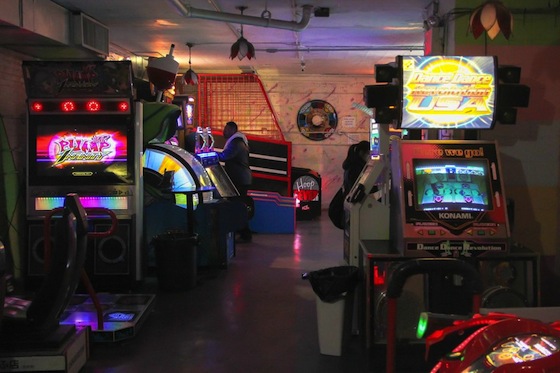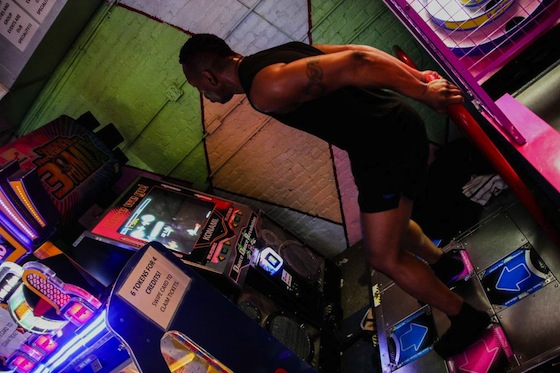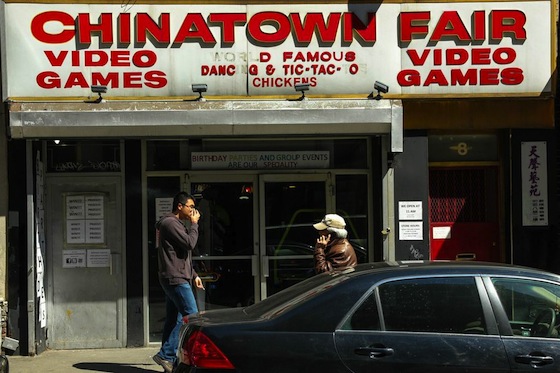Alex is a skinny teenager with shaggy black hair – almost like a Beatles cut. He comes here all the time, just to play this game.

April 24, 2014
New Yorkers lost one of the last video arcades in Manhattan when Chinatown Fair closed down in 2011. But two years ago in May, it reopened under new management. Since then, it’s reinvented itself as a top destination for rhythm game players. Eveline Chao visited on a Saturday night, and returned with this audio portrait of an old Chinatown haunt, which draws visitors from across the five boroughs, as well as from across the country.
Reporter: That’s the sound of Alex C. – gamer name Panera – slamming buttons on the game Beatmania IIDX. It’s a popular game from Japan, where you’re a DJ in a club, and have to “pass” different songs to get to the next level. It’s Alex’s favorite game at Chinatown Fair.
Alex C.: As you can see, there are like – seven buttons and a turntable. That would be single play. There’s also a mode called double play where you…
Reporter: Alex is a skinny teenager with shaggy black hair – almost like a Beatles cut. He comes here all the time, just to play this game. It’s a tiny space, and people keep bumping us as they squeeze PAST. Nearby, some people are playing air hockey and yelling. But Alex is totally oblivious. He’s been standing in front of the IIDX machine for hours, staring into the screen like nothing else exists.
Alex: It’s just my main game right now…Yeah yeah yeah.
Reporter: Chinatown Fair is a New York institution. It’s been open for 60 years, and was most famous for having a chicken that played tic tac toe. It competed with players by pecking its answers from inside a glass box. In the ‘80s, when the neighborhood was rough, it was known as a gang hangout. And when it closed in 2011, it was a popular place for fighter games – games like Street Fighter and Tekken.
Reporter: Since Chinatown Fair reopened two years ago, it’s become known for something new.
Lonny Sobel: Instead of a fighting crowd we’ve become pretty famous literally nationwide for what we call our rhythm and dance crowd.
Reporter: Those are people like Alex, who like to play games that involve music and dancing. They’re called rhythm games.
Lonny Sobel: I … have gotten …people coming from Massachusetts, literally driving 4-5 hours, and one weekend we had people come up from Florida, literally came to play our dance and rhythm games, and all the time they come up from Washington DC; 15-20 kids will come up for the weekend just to play our games.
Reporter: Lonny Sobel is the manager of the new Chinatown Fair. He’s been in the arcade business for 30 years.
Lonny Sobel: I didn’t know it was going to be a dance and rhythm crowd. But we saw that that’s what everybody wanted, so we got more and more and more…
Reporter: Until Beatmania took its place, the most popular game here was Rerave, made by an American company.
Lonny Sobel: We’re ranked number one in the world out of 69 locations – all these great big giant locations in Japan, we’re number one with that Rerave game.
Reporter: Daniel Alvarado is a 29-year-old from the Bronx. He works as a security guard nearby. He’s here with his friend Brian Nazario.
Daniel Alvarado: I come here for free time to play Dance Dance Revolution here, DDR Extreme. It’s one of my favorite games, been playing this for about 12, 13 years now…It’s an excitement.
Brian Nazario: I’m 29 years old, I’ve been coming here since I was a teenager.
Reporter: Brian is from Coney Island. Both of them were pouring sweat from their last round of DDR. For the arcade’s manager, Lonny, catering to rhythm players like Daniel and Brian is a matter of survival.
Lonny Sobel: It’s so easy to play the games at home now. But the dance and rhythm crowd, those are big, big games that just, they don’t exist on your home machine… and the crowd is a very nice crowd, it’s a much calmer crowd than the big fighting crowd. And also, they spend money, whereas the fighting crowd is more of a hanging out kind of crowd.
Reporter: For Alex to find another place with Beatmania IIDX, he’d have to go to New Jersey or California. I asked Alex why he loves it so much.
Alex C.: It’s kind of underground cult thing…I wouldn’t say I’m a hipster but I just really like new things… It was just so interesting because they had all sorts of music that you could never hear anywhere else.
Reporter: But another interesting thing about IIDX? It costs $20,000 new from Japan – though Lonny got it used for a quarter of that. He says most of the games here cost $8 to 10,000 on average.
Lonny Sobel: Rent for that tiny 2,000-square-foot space is crazy high rent, and each machine has to be busy all the time and we have to constantly buy new machines.
Reporter: For gamers like Alex and Daniel, that means it’s not always easy to find a place to play —
Alex C.: There used to be another arcade that had this game but they couldn’t keep up with the rent.
Daniel Alvarado: The places like Palisades Center, they don’t have no more arcades and upstate even, where I was in the Bronx, they don’t have no more either…this is the last surviving arcade spot, basically.
Reporter: How much longer it survives remains to be seen. Friday night was packed, and weekends in general are good, but on weekdays, the place is empty. Judging from loyal customers like Alex and Daniel, though, Lonny’s got a fighting chance.
Daniel Alvarado: As long as there’s a DDR machine, I will come here no matter what.
Reporter: I would have asked Alex what he thought too, but he was too busy playing Beatmania. For Open City, this is Eveline Chao in New York.





